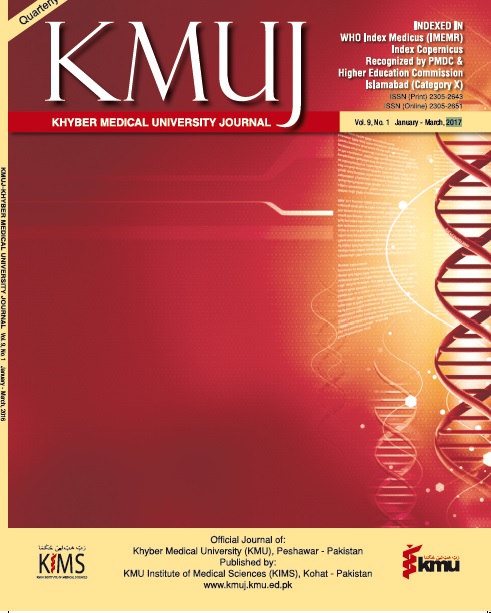EFFECTIVENESS OF DIGITAL MANIPULATION OF THYROID CARTILAGE IN THE MANAGEMENT OF STUTTERING IN ADULTS
Main Article Content
Abstract
OBJECTIVE: To compare the effectiveness of digital manipulation of
thyroid cartilage (DMT) with Fluency Shaping Therapy (FST) for the
management of stuttering in adults.
METHODS: This randomized clinical trial was conducted in Speech-Therapy
department of National Institute of Rehabilitation Medicine Islamabad.
Twenty male adult patients were recruited in the current study
through non-probability, convenience sampling. The participants were
randomly allocated into two equal groups (n=10): DMT group & FST
group. Scale of rating severity of stuttering was used to assess the severity
level at baseline and after the completion of 24 training sessions.
Three vowel approaches with four sets of 5-repetition each were performed
for each vowel in DMT group. Training in FST group comprised
of speech techniques like easy onset, prolongation of speech, continuous
phonation and light articulatory contact in reading and conversation in
three speaking situations (speaking with therapist, reading aloud and
free conversation).
RESULTS: Mean age of the participants in DMT group was 21.4±2.2
years and FST group was 20.9±3.2 years. At baseline, there was no
significant difference between DMT and FST groups regarding the severity
of stuttering (5.3±0.94 vs. 5.6±0.96; p=0.492). As a result of 12
weeks of treatment, both groups demonstrated significant improvement
(p<0.001). There was no significant difference between the groups after
intervention (4.6±1.26 vs 3.8±0.91; p= 0.12).
CONCLUSION: Both DMT and FST techniques are equally effective in
the management of stuttering in adults. Further large scale studies on
adults and children of both genders are needed to compare effectiveness
of DMT and FST.
KEY WORDS
Stuttering (MeSH), Stammering (MeSH), Fluency shaping therapy (Non-MeSH), stuttering modifications therapy (Non-MeSH), Behavior therapy (MeSH), Laryngeal manipulation (Non-MeSH).
Article Details
Work published in KMUJ is licensed under a
Creative Commons Attribution 4.0 License
Authors are permitted and encouraged to post their work online (e.g., in institutional repositories or on their website) prior to and during the submission process, as it can lead to productive exchanges, as well as earlier and greater citation of published work.
(e.g., in institutional repositories or on their website) prior to and during the submission process, as it can lead to productive exchanges, as well as earlier and greater citation of published work.
References
Parry WD. Understanding and controlling stuttering. New York, NY, US: National Stuttering Association. 2009.
Perez HR, Doig-Acuña C, Starrels JL. “Not unless it’s a life or death thing”: a qualita¬tive study of the health care experiences of adults who stutter. J Gen Intern Med 2015 Nov 1;30(11):1639-44. doi: 10.1007/ s11606-015-3302-x. Epub 2015 Apr 9.
Healey EC, Trautman LS, Susca M. Clinical applications of a multidimensional ap¬proach for the assessment and treatment of stuttering. Contemp Issues Commun Sci Disord 2004;31:40-8. [Cited on Novem¬ber 20, 2016]. Available from URL: https:// pdfs.semanticscholar.org/8f49/7cfb969ad¬15b8e448f0f86eb2501aff0d153.pdf
Ratner NB. Evidence-based practice in stuttering: Some questions to consider. J Fluency Disord 2005; 30(3):163-88
Max L, Guenther FH, Gracco VL, Ghosh SS, Wallace ME. Unstable or insufficiently activated internal models and feedback-bi¬ased motor control as sources of dysflu¬ency: A theoretical model of stuttering. Contemp Issues Commun Sci Disord 2004;31(Spring):105-22.
Kazenski D, Guitar B, McCauley R, Falls W, Dutko LS. Stuttering severity and re¬sponses to social-communicative challenge in preschool-age children who stutter. Speech Lang Hear 2014;17(3):142-5
Herder C, Howard C, Nye C, Vanry¬ckeghem M. Effectiveness of behavioral stuttering treatment: A systematic review and meta-analysis. Contemp Issues Com¬mun Sci Disord 2006;33:61-73.
Blood GW, Blood IM, Tellis G, Gabel R. Communication apprehension and self-perceived communication compe¬tence in adolescents who stutter. J Fluency Disord 2001 Nov 30;26(3):161-78.
Sommer M, Koch MA, Paulus W, Weiller C, Büchel C. Disconnection of speech-rel¬evant brain areas in persistent devel¬opmental stuttering. Lancet 2002 Aug 3;360(9330):380-3.
Blanchard EB, Jurish SE, Andrasik F, Epstein LH. The relationship between muscle discrimination ability and response to relaxation training in three kinds of head¬aches. Appl Psychophysiol Biofeedback 1981 Dec 1;6(4):537-45.
Neumann K, Preibisch C, Euler HA, von Gudenberg AW, Lanfermann H, Gall V, et al. Cortical plasticity associated with stuttering therapy. J fluency disord 2005;30(1):23-39.
De Nil LF, Kroll RM, Lafaille SJ, Houle S. A positron emission tomography study of short –and long-term treatment effects on functional brain activation in adults who stutter. J Fluency Disord 2003;28:357-79.
Maqbool M, Maqbool S. (Ed). Puberphoo¬nia Mutional False to voice. Disorder of Voice. Chap 65. In: Textbook of ear, nose and throat disease. 10th edition, New Delhi: Jaypee Brothers Medical Publishers; 2003; pp. 272-3.
Stemple JC, Hapner ER. Voice therapy: clinical case studies. Plural Publishing; Fourth Edition. San Diego, California : Plural Publishing, 2014.
Watts CR. The Voice and Voice Therapy. J Med Speech Lang Pathol 2005 Dec 1;13(4):241-3.
Khan MN, Noor R, Awan WA. The role of digital manipulation of larynx in man¬agement of stuttering; A case study. Int J Rehabil Sci 2015;4(2):56.
O’Brian S, Packman A, Onslow M, O’Brian N. Measurement of stuttering in adults: comparison of stuttering-rate and sever¬ity-scaling methods. J Speech Lang Hear Res 2004 Oct 1;47(5):1081-7.
Brin MF, Stewart C, Blitzer A, Diamond B. Laryngeal botulinum toxin injections for disabling stuttering in adults. Neurol 1994 Dec 1;44(12):2262-6.
Giraud AL, Neumann K, Bachoud-Levi AC, von Gudenberg AW, Euler HA, Lanfer¬mann H, Preibisch C. Severity of dysfluen¬cy correlates with basal ganglia activity in persistent developmental stuttering. Brain Lang 2008 Feb 29;104(2):190-9.
Mathieson L, Hirani SP, Epstein R, Baken RJ, Wood G, Rubin JS. Laryngeal manual therapy: a preliminary study to examine its treatment effects in the management of muscle tension dysphonia. J Voice 2009 May;23(3):353-66.
